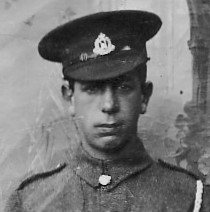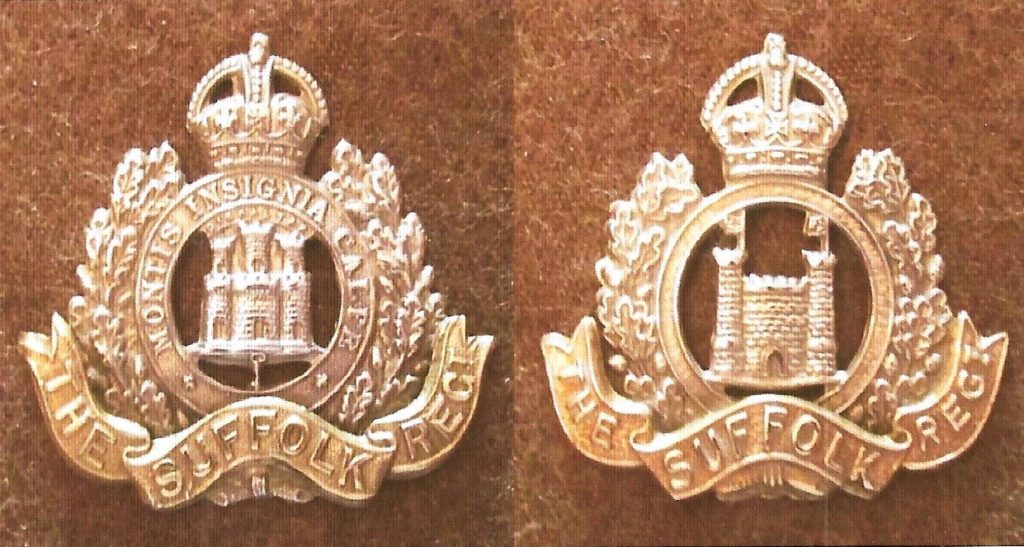200663 LANCE CORPORAL AMOS FRANK HURREN
1/1ST BATTALION CAMBRIDGESHIRE REGIMENT T.F.
ATTACHED TO THE LABOUR CORPS
WHO DIED AT HOME
21ST MARCH 1919
AGE 21 YEARS
Born in Halesworth in the third quarter of 1897, Amos Frank Hurren was the fifth child of Amos senior, a brewer’s labourer, and his wife Eliza (née Spoore). Over time the family would grow to eleven children, with one, a young daughter, dying shortly after her birth. Little information could be found of Amos’s early life, but by the age of 13 years he had left school and had found work as an errand boy employed by one of the town’s tailors, while living with his family at 34 Quay Street, Halesworth. As with so many of those who lost their lives during the Great War his actual military service is difficult to trace due to the loss of the majority of their records during the London Blitz of World War 2. From what records remain, including a copy photograph of Amos in uniform that has been kindly handed in to the town’s museum also an article recording his death in the Halesworth Times newspaper published on 1st April 1919, we can piece together the story of another young man who, although he had survived the conflict would die shortly after the Armistice, possibly from what he had suffered while serving on the Western Front.
In 1914, then aged seventeen, Amos was to be found employed by the Colchester Brewing Company, possibly along side his father, at their then premises located in the town’s marketplace. Within a month of the war against Germany having been declared, he had enlisted to serve with the town’s Territorials of the 4th Battalion, Suffolk Regiment. By early November, having neither completed his basic training nor having reached the required age of nineteen years (at that time the minimum to be allowed to serve overseas) he was not able to cross to France with his Halesworth chums. It is more than likely that, shortly after enlistment, he would have joined what was to become known as the 2nd/4th Battalion, formed at Ipswich during October 1914 and made up of men who were not considered suitable due to their age or lack of training to travel to France with the renamed 1st/4th Suffolks. His initial service with the Suffolk Territorials is confirmed by the photograph of Amos in uniform above, showing him wearing the distinctive cap badge of his regiment although differing from that of Regular troops, as on their formation in 1908 and in line with several other infantry regiments of the Territorial Force, it was felt that the part-timers should not be entitled to wear the same insignia as their regular counterparts as many of their cap badges bore previous Battle Honours or associated Mottos that the regular troops had fought and died for. Within a short time, these differences were dropped after the Territorials more than proved themselves on the field of battle.
Suffolk Regt cap badge Suffolk Regt cap badge
as worn by Regular as worn by Territorials
Troops
After completing his training and having reached the required age Amos eventually would have been sent over to France at some time in early 1916. This can be seen on his medal index card which shows that he had not qualified for either of the star medals issued to those who had served overseas in either 1914 or 1915. His card also shows that, although he had enlisted into the Suffolk Regiment prior to being sent to the front, at some time he had been transferred to their sister regiment, the 1st Battalion Cambridgeshire Regiment, another Territorial formation which, with a small number of other part-time regiments, did not have any Regular Army counterparts and therefore had no conflict regarding their insignia. On joining his new regiment, he initially served as 200663, a Private soldier, later being promoted to Lance Corporal. The article in the Halesworth Times described how Amos had served in France on two separate occasions and recently that he had also been wounded. Depending on the seriousness of his injuries this could have been the reason for his return to England. It could also have been the reason for Amos having later been transferred to serve in the Labour Corps, once again with a new regimental number of 374896. His new Corps had been first formed in 1917 to supply a pool of men who, due to their older age or physical condition caused by illness or wounds, were no longer suitable to serve in front line formations, but were able, in organised military units, to supply a work force capable of carrying out work behind the lines at such places as rail heads and docks etc.
Sadly, the story of Amos losing his young life on the 22nd March 1919 is not uncommon as, at the war’s end, on 11th November 1918, the world was suffering from an influenza pandemic that was more commonly known as the Spanish Flu. This is reported to have lasted, between February 1918 and April 1920, and had taken the lives of some fifty million people from right across the globe. In Britain, with many thousands of men discharged from the armed forces during early 1919, many of those, possibly due to the harsh conditions they had suffered while serving would succumb to the illness. The Halesworth Times article relates that, two weeks after returning home for his demobilisation furlough, he had been taken ill with peritonitis, an acute abdominal infection that causes swelling of the stomach, combined with a fever and possible respiratory distress. Tragically he passed away just five days after being diagnosed on 21st March 1919, aged just twenty-one years. Amos’s funeral was held during the afternoon of Wednesday, 26th March, with many members of his family and townspeople in attendance. Due to him still being a serving soldier he was accorded a full military burial service complete with a firing party supplied by troops of the 35th Battalion, Northumberland Fusiliers T.F. who at that time were based in the nearby village of Westleton. The last post was played by another local lad, Bugler Major (Christian name) Baker, one of the original Halesworth Territorials who lived in Rectory Street and had served right throughout the war from mobilisation to the Armistice. Today Amos’s grave, complete with military headstone, is to be found in the town cemetery in section A, plot 335. As with similar cases, his death must have affected his parents deeply, having previously lost their son Clifford who had been killed in action in October 1915 and then having celebrated the Armistice which, they would have hoped, would see their remaining four serving sons home safe. To lose Amos four months after the end of the “War to End All Wars” must have been devastating.
Due to the family being able to support themselves they would not receive any pension for their two sons but by July 1920 they had received a total gratuity payment of £29.18s.0d (£29.90p) in respect of Amos’s life.
As well as the above monies, his family would also been able to claim his medal entitlement of the British War and Victory medal pair with his named bronze Memorial Plaque and Scroll.
The location of these is not known.
Amos’s grave in the town cemetery



